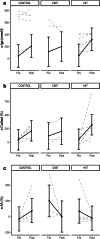The impact of high-intensity interval training exercise on breast cancer survivors: a pilot study to explore fitness, cardiac regulation and biomarkers of the stress systems
- PMID: 32819304
- PMCID: PMC7441660
- DOI: 10.1186/s12885-020-07295-1
The impact of high-intensity interval training exercise on breast cancer survivors: a pilot study to explore fitness, cardiac regulation and biomarkers of the stress systems
Abstract
Background: Cardiovascular disease (CVD) remains the largest cause of death in breast cancer survivors. The aim of this study was to explore the impact of exercise intensity on aerobic fitness and autonomic cardiac regulation (heart rate variability (HRV)) and salivary biomarkers of the stress systems (HPA-axis, cortisol; sympathetic nervous system, α-amylase) and mucosal immunity (secretory(s)-IgA), markers of increased risk of CVD in breast cancer survivors.
Methods: Participants were randomly assigned to; 1) high intensity interval training (HIIT); 2) moderate-intensity, continuous aerobic training (CMIT); or 3) a wait-list control (CON) for a 12-week (36 session) stationary cycling intervention. Cardiorespiratory fitness (VO2peak), resting HRV and salivary biomarkers were measured at baseline 2-4 d pre-intervention and 2-4 d post the last exercise session.
Results: Seventeen participants were included in this study (62 ± 8 years, HIIT; n = 6, CMIT; n = 5, CON; n = 6). A significant improvement (p ≤ 0.05) was observed for VO2peak in the HIIT group; 19.3% (B = 3.98, 95%CI = [1.89; 4.02]) and a non-significant increase in the CMIT group; 5.6% (B = 1.96, 95%CI = [- 0.11; 4.03]), compared with a 2.6% (B = - 0.64, 95%CI = [- 2.10; 0.82]) decrease in the CON group. Post intervention improvements in HRV markers of vagal activity (log (ln)LF/HF, LnRMSSD) and sympathetic nervous system (α-amylase waking response) occurred for individuals exhibiting outlying (> 95% CI) levels at baseline compared to general population.
Conclusion: High intensity interval training improved cardiovascular fitness in breast cancer survivors and improved cardiac regulation, and sympathetic nervous system (stress) responses in some individuals. High-intensity interval training was safe and effective for breast cancer survivors to participate in with promising results as a time efficient intensity to improve physical health and stress, reducing CVD risk.
Trial registration: This pilot study was retrospectively registered through the Australian New Zealand Clinical Trials Registry (ANZCTR): ACTRN12620000684921 .
Keywords: Biomarkers; Cancer; Exercise; Health; High-intensity; Immune function; Stress.
Conflict of interest statement
The authors declare that they have no competing interests.
Figures



References
-
- Giese-Davis J, Wilhelm FH, Conrad A, Abercrombie HC, Sephton S, Yutsis M, et al. Depression and stress reactivity in metastatic breast cancer. Psychosom Med. 2006;68(5):675–683. - PubMed
-
- Paolucci T, Bernetti A, Bai AV, Capobianco SV, Bonifacino A, Maggi G, et al. The recovery of reaching movement in breast cancer survivors: two different rehabilitative protocols in comparison. Eur J Physical Rehabil Med. 2020. - PubMed
-
- Siegel RL, Miller KD, Jemal A. Cancer statistics, 2019. CA Cancer J Clin. 2019;69(1):7–34. - PubMed
Publication types
MeSH terms
Substances
LinkOut - more resources
Full Text Sources
Medical
Research Materials
Miscellaneous

